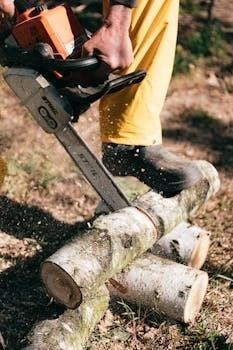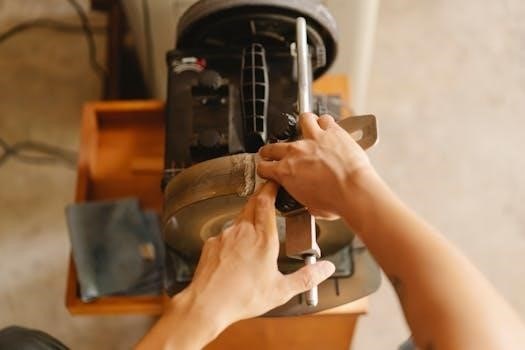
This manual provides essential guidance on maintaining your chainsaw’s cutting performance. Discover the importance of a sharp chain, exploring both manual and electric sharpening methods. Learn about various sharpener types, key features, and top brands like STIHL, Oregon, Granberg and Husqvarna. Proper chainsaw maintenance is crucial for safety and efficiency.
Importance of a Sharp Chainsaw
A sharp chainsaw is paramount for both efficiency and safety. A dull chain not only makes cutting more difficult and time-consuming but also increases the risk of kickback, a dangerous situation for any user. Using a dull chainsaw requires more effort, leading to operator fatigue and potentially causing accidents. Furthermore, a dull chain wastes fuel, as the saw has to work harder to make cuts, resulting in decreased productivity and increased operational costs. A sharp chain, on the other hand, slices through wood smoothly and effortlessly, making the task less strenuous and more enjoyable. Regular sharpening is crucial for maintaining a chainsaw’s performance and ensuring a safe working environment. Therefore, understanding the importance of a sharp chainsaw is the first step in proper chainsaw maintenance. It’s not just about ease of use; it’s about safety, efficiency, and getting the job done right the first time. Investing time in sharpening will save you time and energy in the long run while also minimizing the risk of accidents. A sharp blade is a safe blade.
Manual Chainsaw Sharpening Methods
Manual chainsaw sharpening methods primarily involve using hand files and guides. This traditional approach requires a keen eye and a steady hand to achieve consistent results. The most common technique employs round files to sharpen each cutter tooth, maintaining the correct angle and depth. File guides, like the Tecomec Super Rapid Filing Guide and the Pferd CS-X Chain Sharp Filing Guide, can aid in achieving accurate angles and consistent sharpening. These guides help to ensure that each tooth is sharpened uniformly, leading to optimal cutting performance. While manual sharpening can be slower and more challenging than using electric methods, it offers a cost-effective solution, especially for occasional users. The use of 2-in-1 file guides can simplify the process. Manual sharpening also allows for on-the-go adjustments in the field. The key to successful manual sharpening is patience and practice, as mastering the correct techniques is crucial for achieving a sharp and efficient chain.
Hand Filing Techniques

Hand filing is a fundamental skill for chainsaw maintenance, requiring precision and patience. This method uses round files of varying sizes, depending on the chain type. To begin, secure the chainsaw bar firmly. The file should be positioned at the correct angle, typically indicated by markings on the file guide or the chain itself. Each tooth is then sharpened using smooth, even strokes, pushing the file away from you. Consistency is crucial; each tooth must be filed to the same depth and angle to ensure balanced cutting. The use of a file guide, such as the Tecomec Deluxe Manual Chainsaw Sharpening System, is highly recommended for maintaining accurate angles and depths. It’s essential to periodically check the cutting teeth to ensure uniform sharpening. Hand filing is a cost-effective and portable method, ideal for field maintenance. However, it does require practice to master and achieve professional results. A 2-in-1 file guide can simplify the process, making it more accessible for beginners.
Electric Chainsaw Sharpening Methods
Electric chainsaw sharpeners offer a faster and more consistent approach compared to manual filing. These sharpeners typically utilize grinding wheels or stones to remove material from the cutting teeth. There are several types, including bench-mounted, portable, and wall-mounted units. Bench-mounted sharpeners, such as the Oregon 410-120, provide stability and precision, making them suitable for frequent sharpening. Portable electric sharpeners, like the Oregon Electric Sure Sharp, are convenient for on-site maintenance. These devices often include features like adjustable angles and depth settings, allowing for accurate sharpening of various chain types. The process generally involves securing the chain, aligning the grinding wheel, and making several passes over each tooth. Electric sharpeners can handle different pitches and are faster than manual methods. Regular maintenance, including dressing the grinding wheels with a dressing stone, is essential for optimal performance. While offering convenience and speed, electric sharpeners may be more expensive than manual options. The use of a template/gauge can further aid in achieving consistent results.
Bench Mounted Sharpeners
Bench mounted sharpeners are a type of electric chainsaw sharpener designed for stationary use, typically attached to a workbench for stability. These models, such as the Oregon bench mounted mini grinder, offer a robust and precise sharpening solution; They feature a grinding wheel or stone that rotates at high speed, allowing for efficient material removal from the chain’s cutting teeth. Bench sharpeners usually include adjustable settings for various chain pitches and angles, ensuring consistent sharpening results. They are ideal for users who frequently sharpen chains and require accuracy and repeatability. Many come with features such as a built-in template or gauge to assist in proper alignment. The sharpener’s stability is a key advantage, reducing vibration and allowing for more controlled sharpening. Though they may require more setup than portable options, bench mounted sharpeners provide professional-grade results; Regular maintenance, including using a dressing stone for the grinding wheels, is essential to keep them performing optimally. These sharpeners are a good investment for those who value precision and durability.
Portable Electric Sharpeners
Portable electric sharpeners offer a convenient solution for chainsaw chain maintenance, designed for on-the-go use. These sharpeners, such as the Oregon Electric Sure Sharp, are lightweight and easy to transport. They typically use a grinding stone powered by a corded or cordless motor, allowing you to sharpen chains quickly and efficiently at your job site. These tools often feature a compact design and are user-friendly, making them suitable for both professionals and DIY enthusiasts. Portable electric sharpeners provide a balance between precision and ease of use, making them ideal for those who need to sharpen their chains frequently but don’t want the bulk of a bench mounted machine. They may have adjustable settings for different chain types and angles, allowing for versatility. Some portable models can be easily installed and used in various situations. These sharpeners offer a fast and practical way to maintain your chainsaw’s cutting edge, ensuring a safer and more efficient working environment. They are a valuable tool for anyone using a chainsaw regularly.

Types of Chainsaw Sharpeners
Understanding the different types of chainsaw sharpeners is crucial for effective chain maintenance. Primarily, they can be categorized into manual and electric devices. Manual sharpeners include various files, such as round and flat files, often used with file guides for precise sharpening. These are ideal for those who prefer a more hands-on approach and are often the more economical choice. Electric sharpeners, on the other hand, provide a faster and more consistent sharpening experience. These electric models come in different styles, including bench-mounted, vice-mounted, handheld, and wall-mounted options, each with its own advantages. Bench-mounted electric sharpeners are generally more powerful and suitable for frequent use, while handheld electric sharpeners offer portability and convenience. The choice between manual and electric depends on your needs, budget, and personal preference. Selecting the right type of sharpener is essential for keeping your chainsaw in optimal cutting condition, whether you’re a professional or a homeowner.
Manual vs Electric
Choosing between manual and electric chainsaw sharpeners depends on several factors, including the user’s skill level, frequency of use, and budget. Manual sharpeners, typically involving files and guides, offer a more affordable and portable solution. They require a hands-on approach and a good understanding of proper filing techniques. Manual sharpening is slower but can be very precise if done correctly. Electric sharpeners, conversely, provide speed and consistency, making them suitable for those who sharpen chains frequently. These come in various forms such as bench-mounted, handheld, and wall-mounted models, each with its pros and cons. Bench-mounted sharpeners are robust and ideal for high-volume use, while handheld versions prioritize portability. Electric sharpeners are generally more expensive but save time and ensure more consistent results. Ultimately, the right choice depends on your specific needs and preferences. Consider the trade-offs between cost, convenience, and the precision offered by each type.

Key Features of Chainsaw Sharpeners
When selecting a chainsaw sharpener, several key features should be considered to ensure optimal performance and longevity. Durability and construction are paramount, influencing how well the sharpener withstands regular use. High-quality materials like hardened steel and robust plastics contribute to a longer lifespan. Another critical aspect is compatibility with chain types, as different chains require specific filing angles and depths. Universal sharpeners can accommodate various pitches, while others are designed for specific chain sizes. Electric sharpeners often have features like variable speed, allowing for precise sharpening control. The weight and portability of the sharpener are also factors, especially for those who need to sharpen chains in the field. Some sharpeners come with additional accessories like grinding wheels, templates, and dressing stones, which can enhance the sharpening process. Ultimately, choosing a sharpener that meets your specific needs for durability, compatibility, and ease of use is essential to maintain your chainsaw’s cutting efficiency. Consider these key features to make an informed purchase.

Durability and Construction
The durability and construction of a chainsaw sharpener are crucial factors that directly impact its lifespan and performance. A robust sharpener, crafted from high-quality materials, ensures reliable and consistent results over time. Look for sharpeners with hardened steel components, which provide resistance to wear and tear. The framework should be sturdy and well-built, capable of withstanding the rigors of frequent use. Plastic handles should be made from durable materials that can resist cracking or breaking. The quality of the grinding wheels or files is also important, as they are the primary components responsible for sharpening the chain. A well-constructed sharpener should maintain its integrity and precision even after prolonged use. The materials used in its construction will determine its ability to resist rust and corrosion, especially if the sharpener is exposed to damp conditions. Investing in a durable and well-built sharpener is a worthwhile decision, as it will ultimately provide reliable and long-lasting performance, making the sharpening process more efficient and effective.
Compatibility with Chain Types
When selecting a chainsaw sharpener, its compatibility with various chain types is a critical consideration. Chainsaws come with different chain pitches and gauges, and it’s essential to choose a sharpener that can accommodate these variations. Some sharpeners are designed for universal compatibility, able to handle all common chain sizes, while others are more specialized. Manual sharpeners often rely on different file sizes and gauges, requiring you to match the file to the specific chain type. Electric sharpeners might have adjustable settings to accommodate different pitches. If you have multiple chainsaws with varying chain types, a versatile sharpener is a worthwhile investment. Always consult the manufacturer’s specifications to ensure the sharpener is compatible with your particular chain. Using an incompatible sharpener can lead to improper sharpening, which can damage your chain and reduce its cutting efficiency; A sharpener that can precisely match the angles and depths required by your chain will ensure optimal performance and prolong the lifespan of your chainsaw. This compatibility is essential for both safety and efficiency.
Top Brands in Chainsaw Sharpening
Several brands stand out in the chainsaw sharpening market, each offering a range of tools and equipment to meet different needs. STIHL is a prominent name, known for its high-quality chainsaws and also its sharpening tools, including file handles and 2-in-1 filing guides for convenience. Oregon is another leading brand that provides both electric bench-mounted sharpeners and portable options, catering to both professional users and homeowners. Granberg is well-regarded for its durable, portable filing systems, like the File-N-Joint, which offers easy and precise on-the-bar sharpening. Husqvarna, another major player in the chainsaw industry, also provides a comprehensive selection of sharpening tools including files and kits, ensuring users can maintain their chains to the highest standards. These brands are trusted for their commitment to quality and performance, offering a variety of options from basic hand files to advanced electric sharpeners. When choosing a chainsaw sharpener, considering these top brands will help ensure you find a reliable and effective solution for your needs. Their products are often designed for ease of use and longevity, making chainsaw maintenance easier.
STIHL, Oregon, Granberg, Husqvarna
These four brands are recognized leaders in the chainsaw and chainsaw sharpening industry, each bringing unique strengths to the market. STIHL offers a range of user-friendly sharpening solutions, including their popular 2-in-1 filing guide, designed for both comfort and precision. Oregon stands out with its versatile electric bench-mounted and portable sharpeners, catering to various levels of use. Their bench grinder is a favorite for those needing professional-grade sharpening at home. Granberg specializes in portable, bar-mounted filing systems like the File-N-Joint, known for its ease of use and precision, making on-the-go sharpening simple. Husqvarna provides a wide selection of sharpening tools, from files to kits, ensuring users can maintain peak chain performance. These brands offer everything from basic manual files to advanced electric sharpening systems, ensuring that users can find the perfect tool for their specific needs. Each brand’s dedication to quality and performance makes them a reliable choice for maintaining chainsaw chains, reflecting their years of expertise in the industry. Their products are designed for durability and user satisfaction;